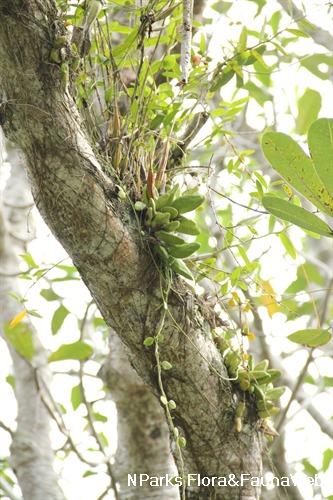
Back
Dischidia major (Vahl) Merr.
| Family Name: | Apocynaceae |
| Synonyms: | Acokanthera , Dischidia rafflesiana Wall. |
| Common Name: | 玉荷包 |
Name
Classifications and Characteristics
| Plant Growth Form | Climber, Epiphyte |
|---|---|
| Lifespan (in Singapore) | Perennial |
| Mode of Nutrition | Autotrophic |
Biogeography
| Native Distribution | Northeast India, Myanmar, Indochina, Thailand, Peninsular Malaysia, Singapore, the Philippines, Borneo, Java, Sulawesi, the Moluccas, New Guinea, and Australia |
|---|---|
| Native Habitat | Terrestrial (Primary Rainforest, Secondary Rainforest, Coastal Forest), Shoreline (Mangrove Forest) |
| Preferred Climate Zone | Tropical |
| Local Conservation Status | Native to Singapore (Least Concern (LC)) |
Description and Ethnobotany
| Growth Form | Twining epiphyte, associated with ants. |
|---|---|
| Foliage | Its latex-containing, opposite leaves have two forms of leaf blades. The smaller leaf blades are flat, rounded, and 2–3 by 1.5–2 cm, adpressed to the host tree or supporting structure. . The other form is oblong, pouch-like, yellowish-green outside, purple inside, and 6–12 by 2–4 cm. This is often inhabited by ants. |
| Flowers | Its flowers are yellow-green, or striped yellow and green, have tubes 6–8 by 3–4 mm, and develop in clusters of 1–6 flowers. |
| Fruit | Its yellow-green fruits are follicles that split open at one side when mature and about 5 by 0.5cm. |
| Habitat | It usually grows on trees along the coasts up to 1,000 m altitude, and in grassland at 800 m altitude. It occurs locally in Changi, Pulau Tekong and Pulau Ubin. |
| Associated Fauna | In Malaysia, associated with ants from the genus Philidris. |
| Etymology | Greek dis, two; Greek askidion, ascidium, alluding to the leaves which may or may not develop into pouches; Latin major, larger, the reference to which is unknown |
| Ethnobotanical Uses | Medicinal: Its
roots are chewed with betel to treat cough. Cultural / Religious: Along with Dischidia pectinoides, another species with modified leaves, this species has become increasingly popular with Chinese growers in recent years. The purse like leaves of these two species are believed to bring wealth and prosperity to their growers. |
Landscaping Features
| Landscaping | It may be suitable for parks and roadsides. |
|---|---|
| Desirable Plant Features | Ornamental Foliage |
| Landscape Uses | Parks & Gardens, Small Gardens, Coastal, Beachfront / Shoreline, Container Planting, Suitable for Hanging Baskets |
| Thematic Landscaping | Bird & Wildlife Garden |
| Usage Hazard - Cons | Toxic Upon Ingestion |
| Usage Hazard - Cons Remarks | Avoid contact with milky/ white sap as it may cause skin irritation in certain individuals. Keep plants away from children and pets as sap could be toxic. Modified leaves may also invite ants. |
Fauna, Pollination and Dispersal
| Pollination Method(s) | Biotic (Fauna) |
|---|---|
| Seed or Spore Dispersal | Abiotic |
Plant Care and Propagation
| Light Preference | Full Sun, Semi-Shade |
|---|---|
| Water Preference | Moderate Water |
| Rootzone Tolerance | Shallow Media, Easy to Grow |
| Pest(s) | Sucking Insects |
| Propagation Method | Seed, Stem Cutting (Herbaceous) |
Foliar
| Foliage Retention | Evergreen |
|---|---|
| Mature Foliage Colour(s) | Green, Yellow / Golden |
Floral (Angiosperm)
| Flower Colour(s) | Green, Yellow / Golden |
|---|
Fruit, Seed and Spore
| Mature Fruit Colour(s) | Green, Yellow / Golden |
|---|---|
| Fruit Classification | Simple Fruit |
| Fruit Type | Dehiscent Dry Fruit , Follicle |
Image Repository
Others
| Master ID | 30911 |
|---|---|
| Species ID | 5288 |
| Flora Disclaimer | The information in this website has been compiled from reliable sources, such as reference works on medicinal plants. It is not a substitute for medical advice or treatment and NParks does not purport to provide any medical advice. Readers should always consult his/her physician before using or consuming a plant for medicinal purposes. |






.jpg)
.jpg)
.jpg)
